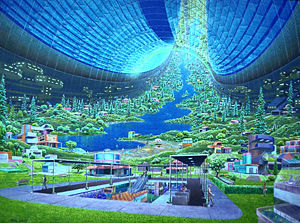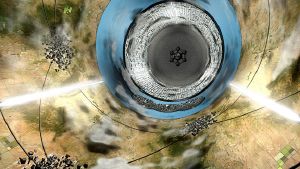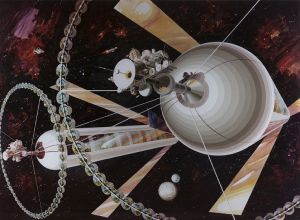Space habitat

A space habitat, also called a space colony, orbital colony, space city, or space settlement, is a space station intended as a permanent settlement rather than as a simple waystation or other specialized facility. No space habitat has yet been constructed beyond Earth orbit, but many design proposals have been made with varying degrees of realism by engineers as well as science fiction authors.
Several reasons have been given in support of space colonization. They include security, profits, energy, and raw materials. For example, space habitats are likely to be less affected by disasters that damage the Earth. On the other hand, space habitats themselves pose a number of challenges, such as the need to provide adequate air, food, water, shelter, energy, and so forth, to maintain healthy human populations.
History
About 1970, near the end of Project Apollo, Gerard K. O'Neill, an experimental physicist, was looking for a topic to tempt his physics students, most of whom were freshmen in engineering. He hit upon the creative idea of assigning them feasibility calculations for large space habitats. To his surprise, the habitats seemed feasible even in very large sizes: cylinders five miles (8 km) wide and twenty miles (34 km) long, even if made from ordinary materials such as steel and glass. Also, the students solved problems such as radiation protection from cosmic rays (almost free in the larger sizes), getting naturalistic sun angles, provision of power, realistic pest-free farming and orbital attitude control without reaction motors. He published an article about these colony proposals in Physics Today in 1974. (See the above illustration of such a colony, a classic "O'Neill Colony"). The article was expanded in the book High Frontier.
The result motivated NASA to sponsor a couple of summer workshops led by Dr. O'Neill.[1][2] Several designs were studied, some in depth, with sizes ranging from 1,000 to 10,000,000 people. Attempts were made to make the habitats as self-supporting as possible, but all of the designs relied on regular shipments from Earth or the Moon, notably for raw materials and volatiles. Closed ecologies and aggressive recycling should dramatically reduce this reliance. Recent research has increased the probability of finding frozen water in deep craters on the moon's south pole, and found that certain asteroids contain significant amounts of volatiles such as water and ammonia. Therefore, space habitats could rely less on Earth than the original studies indicated.
At the time, colonization was definitely seen as an end in itself. The basic proposal by O'Neill had an example of a payback scheme: Construction of solar power satellites from lunar materials. O'Neill's intention was not to build solar power satellites as such, but rather to give an existence proof that orbital manufacturing from lunar materials could generate profits. He, and other participants, presumed that once such manufacturing facilities were on-line, many profitable uses for them would be found, and the colony would become self-supporting and begin to build other colonies as well.
The proposals and studies generated a notable groundswell of public interest. One effect of this expansion was the founding of the L5 Society in the U.S., a group of enthusiasts that desired to build and live in such colonies. The group was named after the space-colony orbit that was then believed to be the most profitable, a kidney-shaped orbit around either of Earth's lunar Lagrange points 5 or 4.

In this era, Dr. O'Neill also founded the quieter, and more targeted Space Studies Institute, which initially funded and constructed prototypes of much of the radically new hardware needed for a space colonization effort, as well as a number of paper studies of feasibility. One of the early projects, for instance, was a series of functional prototypes of a mass driver, the essential technology to be used to economically move ores from the Moon to space colony orbits.
In 1986, the L5 Society became the National Space Society, and former members started a number of related efforts, including the Artemis Project, and the Mars Society. As well, some former L5 Society members seem to be active in radical engineering groups such as the Extropian Institute. A number of prominent modern space engineers and rocket scientists trace their motivation to this era.
The space habitats have inspired a large number of fictional societies in Science Fiction. Some of the most popular and recognizable are the Japanese Gundam universe, Star Trek, and Babylon 5.
Motivation
There are several prominent reasons for space colonization: security, profits, energy and raw materials.
Space habitats are likely to be less affected by disasters that damage the Earth, such as overpopulation, or ocean strikes by large bolides (such as meteorites). Although an individual habitat is probably less secure than Earth, many habitats together add substantially to human survivability. They provide opportunities for migration.
Space has most of the same raw materials found on Earth, and large amounts of energy. It should be possible to make profits, if the infrastructure for space mining and space manufacturing can be created. The initial investments required are large, but the profitability is potentially open-ended.
For example, some proponents estimate that compared to Earth, a family or company might easily triple or quadruple their incomes. Costs might be lower as well. Proponents' estimates of the cost of space colony land work out to roughly $30,000 per acre ($7.50/m²) in 1995 USD, in large economical space colonies. While expensive for rural land, it is inexpensive for city land.
As there exists a vast amount of material to build with in the solar system, and as a space habitat is out of planetary gravity wells, allowing for relatively cheap travel and movement of materials, a vast population using multiple habitats could live and work in space permanently. The Earth can be viewed as quite small, overpopulated and restrictive compared to outer space.
Habitats outside the shadows of planets can use solar power 24 hours a day. Zero-g enables the creation of extremely large-yet-flimsy concentrating mirrors to gather this constant and abundant energy. As well, colonies may employ nuclear power, which wouldn't have all the same environmental and safety concerns that might be present with a nuclear installation on Earth.
Advantages
Space habitats orbiting Earth have a number of potential advantages over those on the surface of other planets:
- Adjustable artificial gravity, via changing a colony's rotation speed. This attribute is important if humans born and raised on the colonies are to be able to return to Earth. It is expected that those born on low-gravity bodies (such as the Moon or Mars) could result in insufficient skeletal strength to function effectively in Earth's higher gravity without significant habilitation.
- Access to vast resources, including the material of the solar system's asteroids (see Asteroid mining).
- Constant access to solar energy.
- Immense population capacity. Using the free-floating resources of the solar system, current estimates extend into the trillions.[3]
- Easier trade with Earth than planetary colonies, as colonies orbiting Earth will not have a gravity well to overcome to export to Earth, and a smaller gravity well to overcome to import from Earth.
Problems
Space habitats must solve a number of problems in order to maintain healthy normal human populations. Some of these issues are discussed below.
Internal life support systems
Air pressure with normal partial pressures of oxygen, carbon dioxide and nitrogen is a basic requirement of any space habitat. Basically, most colony designs are large, thin-walled pressure vessels. Oxygen is available from lunar rock. Nitrogen is available from the Earth but nitrogen is recycled nearly perfectly. Also, nitrogen may be available from comets and outer planets' moons in the form of ammonia. Nitrogen may also be available in unknown quantities on certain other bodies in the outer solar system. The air can be recycled in a number of ways. The obvious method is to use photosynthetic gardens, possibly using hydroponics or forest gardening. However, these do not remove some industrial pollutants, such as volatile oils, and excess simple molecular gases. The standard method used on nuclear submarines is to use a catalytic burner, which effectively removes most organics. Further protection might be provided by a small cryogenic distillation system to gradually remove impurities such as mercury vapor, and noble gases that cannot be catalytically burned.
Organic materials for food production must also be provided. At first, most of these would have to be imported from the Moon, asteroids, or the Earth. After that, recycling would reduce the need for imports. One proposed recycling method would start by burning the cryogenic distillate, plants, garbage and sewage with air in an electric arc, and distilling the result. The resulting carbon dioxide and water would be immediately usable in the farms. The nitrates and the salts in the ash would be dissolved in water and separated into pure minerals. Most of the nitrates, potassium and sodium salts would effectively recycle as fertilizers. Other minerals containing iron, nickel, and silicon could be chemically purified in batches and reused industrially. The small fraction of remaining materials, well below 0.01 percent by weight, could be processed into pure elements with zero-gravity mass spectrography, and added in appropriate amounts to the fertilizers and industrial stocks. This method's only current existence is a proof considered by NASA studies. It's likely that methods would be greatly refined as people begin to actually live in space habitats.
Artificial gravity. Long-term on-orbit studies have proven that zero gravity weakens bones and muscles, and upsets calcium metabolism and immune systems. Most people have a continual stuffy nose or sinus problems, and a few people have dramatic, incurable motion sickness. Most colony designs would rotate in order to use inertial forces to simulate gravity. NASA studies with chickens and plants have proven that this is an effective physiological substitute for gravity. Turning one's head rapidly in such an environment causes a "tilt" to be sensed as one's inner ears move at different rotational rates.
Centrifuge studies show that people get motion-sick in habitats with a rotational radius of less than 100 meters, or with a rotation rate above 3 rotations per minute. However, the same studies and statistical inference indicate that almost all people should be able live comfortably in habitats with a rotational radius larger than 500 meters and below 1 RPM. Experienced persons were not merely more resistant to motion sickness, but could also use the effect to determine "spinward" and "antispinward" directions in the centrifuges.
Protection from hostile external environment
Radiation: Space radiation has two distinct problems. One is that cosmic rays expose one to 80 millisieverts per year, well above the maximum safe occupational threshold of 50 mSv, and well above the healthy population maximum of 3 mSv. Another, separate issue is that solar flares occasionally emit very large amounts of soft x-rays, and energetic particles. When these events occur, they can exceed 4 sieverts, the lethal dose for half the population. The most interesting result of the studies was the discovery that large space habitats are effectively shielded by their structure and air, which easily exceeds the two meters of steel needed. Smaller habitats could be shielded by stationary (nonrotating) bags of rock. Sunlight could be admitted indirectly via mirrors in radiation-proof louvers, which would function in the same manner as a periscope. Heat rejection: The colony is in a vacuum, and therefore resembles a giant thermos bottle. The sunlight to radiated energy ratio can be reduced and controlled with large venetian blinds. Habitats also need a radiator to eliminate heat from absorbed sunlight and organisms. Very small habitats might have a central vane that rotates with the colony. In this design, convection would raise hot air "up" (toward the center), and cool air would fall down into the outer habitat. Some other designs would distribute coolants, such as chilled water from a central radiator. Because blinds and radiators might be a major expense, inexpensive habitats might be very warm. Foreign objects: The habitat would need to withstand potential impacts from space debris, meteoroids, dust, and so on.
Transportation and maneuvering
Orbital stationkeeping. The optimal habitat orbits are still debated, and are probably a commercial issue. The lunar L4 and L5 orbits are now thought to be too far away from the moon and Earth. A more modern proposal is to use a two-to-one resonance orbit that alternately has a close, low-energy (cheap) approach to the moon, and then to the Earth. This provides quick, inexpensive access to both raw materials and the major market. Most colony designs plan to use electromagnetic tether propulsion, or mass drivers used as rocket motors. The advantage of these is that they either use no reaction mass at all or use cheap reaction mass.
Attitude control. Most mirror geometries require something on the habitat to be aimed at the sun. The original O'Neill design used the two cylinders as momentum wheels to roll the colony, and pushed the sunward pivots together or apart to use precession to change their angle. Later designs rotated in the plane of their orbit, with their windows pointing at right angles to the sunlight, and used lightweight mirrors that could be steered with small electric motors to follow the sun.
Designs (solutions)
NASA designs
Designs proposed in NASA studies included:
- Bernal sphere—Island One, a spherical habitat for about 20,000 people.
- Stanford torus—A larger alternative to Island One.
- O'Neill cylinder—Island Three (pictured), the largest design.
- Lewis One[4]
- A "bolo"—a spacecraft or habitat connected by a cable to a counterweight or other habitat. This design has been proposed as a Mars ship, initial construction shack for a space habitat, and orbital hotel. It has a comfortably long and slow rotational radius for a relatively small station mass. Also, if some of the equipment can form the counter-weight, the equipment dedicated to artificial gravity is just a cable, and thus has a much smaller mass-fraction than in other designs. This makes it a tempting design for a deep-space ship. For a long-term habitation, however, radiation shielding must rotate with the habitat, and is extremely heavy, thus requiring a much stronger and heavier cable.
- "Beaded habitats;" this speculative design was also considered by the NASA studies, and found to have a roughly equivalent mass fraction of structure and therefore comparable costs. Small habitats would be mass-produced to standards that allow the habitats to interconnect. A single habitat can operate alone as a bolo. However, further habitats can be attached, to grow into a "dumbbell" then a "bow-tie," then a ring, then a cylinder of "beads," and finally a framed array of cylinders. Each stage of growth shares more radiation shielding and capital equipment, increasing redundancy and safety while reducing the cost per person. This design was originally proposed by a professional architect because it can grow much like Earth-bound cities, with incremental individual investments, unlike designs that require large start-up investments. The main disadvantage is that the smaller versions use a large amount of structure to support the radiation shielding, which rotates with them. In large sizes, the shielding becomes economical, because it grows roughly as the square of the colony radius. The number of people, their habitats and the radiators to cool them grow roughly as the cube of the colony radius.
Other designs
- Bubbleworld; The Bubbleworld, or Inside/Outside concept, was originated in 1964 by Dandridge M. Cole and Donald W. Cox in a nonfiction book called Islands in Space: The Challenge of the Planetoids.[5]
The concept calls for a large asteroid of iron or nickel-iron composition to have a tunnel drilled through its longest axis of rotation and filled with a volatile substance, possibly water. A very large solar reflector would be constructed nearby, focusing solar heat onto the asteroid, first to weld and seal the tunnel ends, then more diffusely to slowly heat the entire outer surface. As the metal softens, the water inside expands and inflates the mass, while rotational forces help shape it into a cylindrical form. Once expanded and allowed to cool, it can be spun to produce artificial gravity, and the interior filled with soil, air and water. By creating a slight bulge in the middle of the cylinder, a ring-shaped lake can be made to form. Reflectors will allow sunlight to enter and to be directed where needed. Clearly, this method would require a significant human and industrial presence in space to be at all feasible.
The Bubbleworld concept was popularized by science fiction author Larry Niven. Niven used the idea in his fictional Known Space stories, describing these worlds as the primary habitats of the Belters, a civilization who had colonized the Asteroid Belt.
See also
Notes
- ↑ NASA, Space Settlements: A Design Study. Retrieved December 19, 2008.
- ↑ Space, Ames Summer Study on Space Settlements and Industrialization Using Nonterrestial Materials. Retrieved December 19, 2008.
- ↑ Gerard K. O'Neill, The colonization of space, Physics Today (1974).
- ↑ Al Globus, Lewis One Space Colony. Retrieved December 19, 2008.
- ↑ Dandridge M. Cole and Donald W. Cox, Islands in Space: The Challenge of the Planetoids (Philadelphia, PA: Chilton Books, 1964).
ReferencesISBN links support NWE through referral fees
- Matloff, Gregory L., Les Johnson, and C. Bangs. 2007. Living Off the Land in Space: Green Roads to the Cosmos. New York, NY: Springer. ISBN 0387360549.
- Schmidt, Stanley, and Robert Zubrin. 1996. Islands in the Sky: Bold New Ideas for Colonizing Space. New York, NY: John Wiley. ISBN 0471135615.
- Seedhouse, Erik. 2008. Tourists in Space: A Practical Guide. Berlin, DE: Springer. ISBN 9780387746432.
External links
All links retrieved February 7, 2023.
- Space Settlements.
- Lifeboat Foundation Space Habitats, a space habitat advocacy group.
| |||||||||||||||||||
Credits
New World Encyclopedia writers and editors rewrote and completed the Wikipedia article in accordance with New World Encyclopedia standards. This article abides by terms of the Creative Commons CC-by-sa 3.0 License (CC-by-sa), which may be used and disseminated with proper attribution. Credit is due under the terms of this license that can reference both the New World Encyclopedia contributors and the selfless volunteer contributors of the Wikimedia Foundation. To cite this article click here for a list of acceptable citing formats.The history of earlier contributions by wikipedians is accessible to researchers here:
The history of this article since it was imported to New World Encyclopedia:
Note: Some restrictions may apply to use of individual images which are separately licensed.

